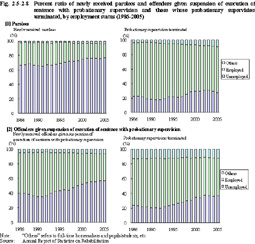| Previous Next Index Image Index Year Selection | |
|
|
4 Termination of probationary supervision Fig. 2-5-2-7 shows the percent ratio of parolees and offenders given suspension of execution of sentence with probationary supervision whose probationary supervision terminated in 2005 by reason.
Fig. 2-5-2-7 Percent ratio of probation/parole termination by sex and by reason (2005) Looking at the percentage of parole/probation revocation in 2005, although the length of supervision periods differ between parolees and offenders given suspension of execution of sentence with probationary supervision, 5.8% of parolees (980 persons) were subject to revocation of parole, and 32.6% of offenders given suspension of execution of sentence with probationary supervision (1,717 persons) were subject to revocation of suspended sentence.Looking at the percentage of parole/probation revocation in 2005 by employment status at the point of revocation, those unemployed show much higher percentage than those employed (probationary supervision was revoked for 15.7% of unemployed parolees and 60.3% of unemployed probationers, in contrast, for 2.2% of employed parolees and 14.5% of employed probationers) (Source: Annual Report of Statistics on Rehabilitation). Fig. 2-5-2-8 shows the trends in the percent ratio of newly received parolees and offenders given suspension of execution of sentence with probationary supervision and those whose probationary supervision terminated, by employment status over the last 20 years. Although newly received parolees and offenders given suspension of execution of sentence with probationary supervision and those whose probationary supervision terminated in the same year are not necessarily the same, the ratio of those employed was much higher among those whose probationary supervision terminated than among those newly received. However, 27.2% of parolees and 36.9% of offenders given suspension of execution of sentence with probationary supervision whose probationary supervision terminated in 2005 remained unemployed. Fig. 2-5-2-8 Percent ratio of newly received parolees and offenders given suspension of execution of sentence with probationary supervision and those whose probationary supervision terminated, by employment status (1986-2005) |

